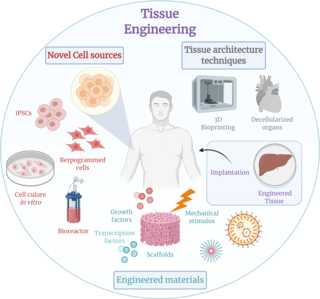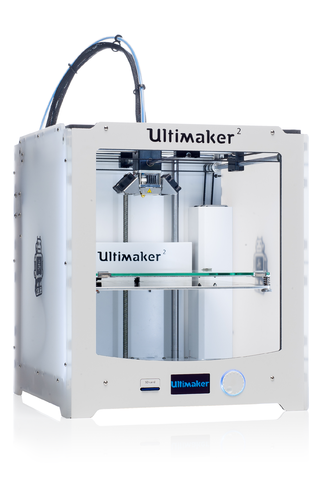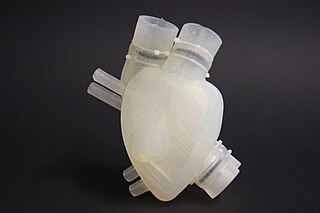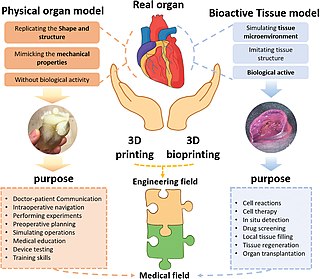Printing techniques
Stereolithography is a 3D-printing technique that uses photopolymerization to bind substrate that has been laid layer upon layer, creating a polymeric network. As opposed to fused-deposition modeling, where the extruded material hardens immediately to form layers, 4D printing is fundamentally based in stereolithography, where in most cases ultraviolet light is used to cure the layered materials after the printing process has completed. [7] Anisotropy is vital in engineering the direction and magnitude of transformations under a given condition, by arranging the micromaterials in a way so that there is an embedded directionality to the finished print. [8] [9]
Fiber architecture

Most 4D printing systems utilize a network of fibers that vary in size and material properties. 4D-printed components can be designed on the macro scale as well as the micro scale. Micro scale design is achieved through complex molecular/fiber simulations that approximate the aggregated material properties of all the materials used in the sample. The size, shape, modulus, and connection pattern of these material building blocks have a direct relationship to the deformation shape under stimulus activation. [4] [10]
Hydro-reactive polymers/hydro gels
Skylar Tibbits is the director of the Self-Assembly Lab at MIT, and worked with the Stratasys Materials Group to produce a composite polymer composed of highly hydrophilic elements and non-active, highly rigid elements. The unique properties of these two disparate elements allowed up to 150% swelling of certain parts of the printed chain in water, while the rigid elements set structure and angle constraints for the transformed chain. They produced a chain that would spell "MIT" when submerged in water, and another chain that would morph into a wire frame cube when subjected to the same conditions. [1]
Cellulose composites
Thiele et al. explored the possibilities of a cellulose-based material that could be responsive to low-humidity. They developed a bilayer film using cellulose stearoyl esters with different substitution degrees on either side. One ester had a substitution degree of 0.3 (highly hydrophilic) and the other had a substitution degree of 3 (highly hydrophobic.) When the sample was cooled from 50 °C to 22 °C, and the relative humidity increased from 5.9% to 35%, the hydrophobic side contracted and the hydrophilic side swelled, causing the sample to roll up tightly. This process is reversible, as reverting the temperature and humidity changes caused the sample to unroll again. [8]
Understanding anisotropic swelling and mapping the alignment of printed fibrils allowed A. Sydney Gladman et al. to mimic the nastic behavior of plants. Branches, stems, bracts, and flowers respond to environmental stimuli such as humidity, light, and touch by varying the internal turgor of their cell walls and tissue composition. [11] Taking precedent from this, the team developed a composite hydrogel architecture with local anisotropic swelling behavior that mimics the structure of a typical cell wall. Cellulose fibrils combine during the printing process into microfibrils with a high aspect ratio (~100) and an elastic modulus on the scale of 100 GPa. These microfibrils are embedded into a soft acrylamide matrix for structure.
The viscoelastic ink used to print this hydrogel composite is an aqueous solution of N,N-dimethylacrylamide, nanoclay, glucose oxidase, glucose, and nanofibrillated cellulose. The nanoclay is a rheological aid that improves liquid flow, and the glucose prevents oxygen inhibition when the material is cured with ultraviolet light. Experimenting with this ink, the team created a theoretical model for a print path that dictates the orientation of cellulose fibrils, where the bottom layer of the print is parallel to the x-axis and the top layer of the print is rotated anticlockwise by an angle θ. The curvature of the sample is dependent on elastic moduli, swelling ratios, and ratios of layer thickness and bilayer thickness. Thus, the adjusted models that describe mean curvature and Gaussian curvature are, respectively,
and
Gladman et al. found that as θ approaches 0°, the curvature approximates the classical Timoshenko equation and performs similarly to a bimetallic strip. But as θ approaches 90°, the curvature transforms into a saddle shape. Understanding this, then, the team could carefully control the effects of anisotropy and break lines of symmetry to create helicoids, ruffled profiles, and more. [9]
Thermo-reactive polymers/hydrogels
Poly(N-isopropylacrylamide), or pNIPAM, is a commonly used thermo-responsive material. A hydrogel of pNIPAM becomes hydrophilic and swollen in an aqueous solution of 32 °C, its low critical solution temperature. Temperatures above that start to dehydrate the hydrogel and cause it shrink, thus achieving shape transformation. Hydrogels composed of pNIPAM and some other polymer, such as 4-hydroxybutyl acrylate (4HBA,) exhibit strong reversibility, where even after 10 cycles of shape change there is no shape deformation. [8] [12] Shannon E. Bakarich et al. created a new type of 4D-printing ink composed of ionic covalent entanglement hydrogels that have a similar structure to standard double-network hydrogels. The first polymer network is cross-linked with metal cations, while the second is cross-linked with covalent bonds. This hydrogel is then paired with a pNIPAM network for toughening and thermal actuation. In lab testing, this gel showed a shape recovery of 41%-49% when the temperature increased 20–60 °C (68–140 °F), and then was restored to 20 °C. A fluid controlling smart valve printed from this material was designed to close when touching hot water and open when touching cold water. The valve successfully stayed open in cold water and reduced the flow rate of hot water by 99%. This new type of 4D-printed hydrogel is more mechanically robust than other thermally actuating hydrogels and shows potential in applications such as self-assembling structures, medical technology, soft robotics, and sensor technology. [13]


Digital shape-memory polymers

Shape-memory polymers (SMPs) are able to recover their original shape from a deformed shape under certain circumstances, such as when exposed to a temperature for a period of time. Depending on the polymer, there may be a variety of configurations that the material may take in a number of temperature conditions. Digital SMPs utilize 3D-printing technology to precisely engineer the placement, geometry, and mixing and curing ratios of SMPs with differing properties, such as glass transition or crystal-melt transition temperatures. [14] Yiqi Mao et al. used this to create a series of digital SMP hinges that have differing prescribed thermo-mechanical and shape memory behaviors, which are grafted onto rigid, non-active materials. Thus, the team was able to develop a self-folding sample that could fold without interfering with itself, and even interlock to create a more robust structure. One of the projects include a self-folding box modeled after a USPS mailbox. [15]
Qi Ge et al. designed digital SMPs based on constituents with varying rubbery moduli and glass-transition temperatures with extremely high-failure strains of up to 300% larger than existing printable materials. This allowed them to create a multi-material gripper that could grab and release an object according to a temperature input. The thick joints were made of SMPs for robustness, while the tips of the microgrippers could be designed separately to accommodate a safe contact for the object of transport. [7]
Stress relaxation
Stress relaxation in 4D printing is a process in which a material assembly is created under stress that becomes "stored" within the material. This stress can later be released, causing an overall material shape change. [16]
Thermal photo-reactive polymers
This type of polymeric actuation can be described as photo-induced stress relaxation.
This technology takes advantage of temperature driven polymer bending by exposing the desired bending seams to focused strips of intense light. These bending seams are printed in a state of stress but do not deform until exposed to light. The active agent that induces bending in the material is heat transmitted by intense light. The material itself is made of chemical photo-reactive polymers. These compounds use a polymer mixture combined with a photoinitiator to create an amorphous, covalent cross-linked polymer. This material is formed into sheets and loaded in tension perpendicular to the desired bending crease.
The material is then exposed to a specific wavelength of light, as the photoinitiator is consumed it polymerizes the remaining mixture, inducing photo initiated stress relaxation. The portion of material exposed to the light can be controlled with stencils to create specific bending patterns. It is also possible to run multiple iterations of this process using the same material sample with different loading conditions or stencil masks for each iteration. The final form will depend on the order and resulting form of each iteration. [16]













